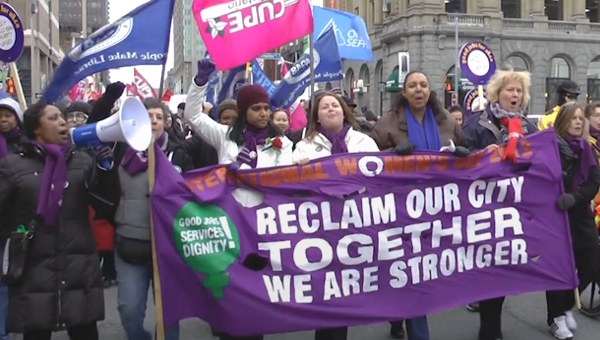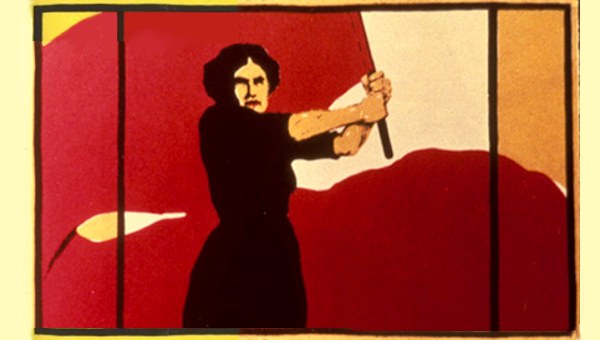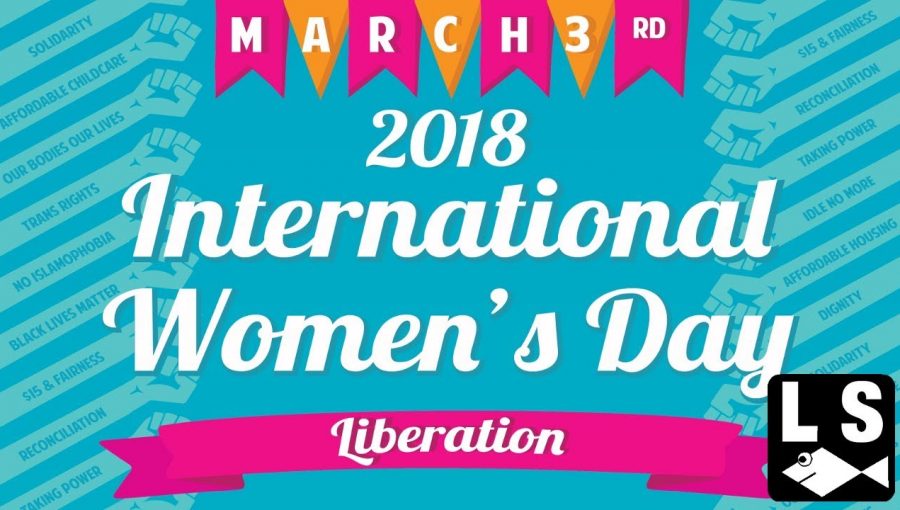International Women’s Day: What is Canadian Feminism?
Feminism has been categorized variously as theory, ideas, organizations, movements, sensibilities, feelings, even a way of living. It can be some and all of those. However, if we define it too expansively, it can dissolve into an amorphous description of all women’s empowering political activity. Feminism is more specific: it questions, challenges, and hopes to alter women’s subordination; it encompasses women’s efforts to secure equality, autonomy, and dignity. Can we apply a “feminist” label to women in the past despite their seeming refusal of the term? If we redefine feminism, I think we can.
Feminists understood women to be disadvantaged by their gender, but the origins and experience of disadvantage might be attributed to sexual oppression, patriarchy, class exploitation, racism, colonialism, heterosexism – or combinations of those. Some liberal definitions of feminism stress women’s individual desire to throw of restrictive “encumbrances” as they seek “the self-determination of a freely choosing, autonomous person.” What this definition misses, however, is that autonomy and dignity may be expressed as collective ideals: women from subordinated groups saw women’s emancipation as inseparable from the just treatment of their communities.
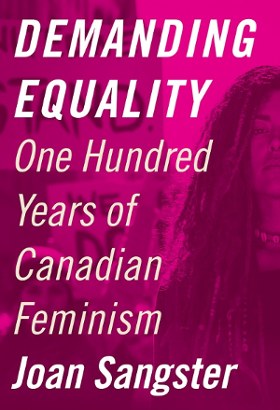
Demanding Equality argues that Canadian feminism was polyphonic; it was a chorus of diverse political voices (not necessarily singing in harmony) rather than solos sung by a few women leaders. It is difficult to distinguish a singular feminist consciousness or movement: rather, groups of feminists fashioned different dreams of equality, freedom, and social transformation. Feminism was often a hybrid politics, in which women saw independence, equality, and dignity intertwined with against related injustices, whether racism, war, colonialism, economic inequality, or homophobia.
Certainly, we should not underestimate women’s oppression. It is undeniable that women’s lives from the 1880s to the 1980s not only differed dramatically from men’s but were valued less; women were more constrained than men and regulated and denigrated in ways men were not.
For decades, they could not vote, sit on juries, run for office, have control over their wages, own their own property as married women, secure a divorce on the same terms as men, have custody of their children – the list goes on. Countless laws – such as those delineating self-defence, Indian status, sexual assault – were written in accordance with dominant ideals of patriarchy and masculinity. Social welfare policies similarly encoded gender and racial hierarchies.
All of these political, legal, and social inequalities were qualified and differentiated for women based on their social location: their class, race, ethnicity, sexual orientation, religion, place of origin. Because women’s experiences diverged so dramatically, their understanding of feminism and (in)equality differed too. Women of Asian descent could not vote in British Columbia until long after white women secured the franchise; working-class women had fewer economic options and faced more acute economic deprivation than middle-class women; Québec women struggled with intense clerical opposition to equal rights; Indigenous women were subject to the colonial violence of racism and sexism. Indeed, the very meaning of democracy diverged between Indigenous and Eurocentric cultures, and the latter have dominated the history of feminism.
Broadening our definition of feminism, and recognizing that its political, cultural, and social dimensions are entangled, allows us to capture the heterogeneity of feminism and also destabilize the unfortunately tenacious model of feminist waves: the first encompassing suffrage campaigns circa 1900; the second emerging in the 1960s, with more emphasis on sexual liberation; the third taking shape in the 1990s. Despite many historical critiques, the “waves” concept has proven stubbornly popular.
Slotting feminism into waves is problematic not only because it falsely assumes these waves were followed by troughs of inactivity, but also because it obscures the feminist activism of left-wing, labour, ethnic, and racialized women. It also assumes waves are defined and driven by a peer group with a shared political agenda, and fails to acknowledge the ideological differences within feminism in all time periods.
Navigating fragmentary and frustratingly incomplete sources detailing women’s political activities is a perennial concern of feminist historians; every source has its own partialities and challenges, but, pieced together, counterposed to each other, they enable us to reconstruct a more fulsome account of multiple streams of feminist activity. Redefining what is “political” has been essential: rather than tallying up numbers of women successfully running for legislative office, historians have probed local and fleeting mobilizations, unpaid as well as paid work, and efforts to alter the “private” sphere of bodies, families, and relationships. We know that textual and visual records tend to favour the more literate, affluent, English and French speakers, and those with a leadership or public presence.
Feminists were not always cognizant of the historical impact of their activities, they seldom left caches of personal papers, and they were less likely to be sought out by the government, media, or experts for their views. Some were just plain busy, doing the double or triple labour of family care, paid work, and politics, without the time or proclivity to document their political actions and reflections. This was especially so for working-class and racialized women, who often pursued their own pathways to equality, so it is particularly important to locate their equality-seeking efforts. Indigenous women also drew on different cultural practices of historical remembering that were not recorded in our colonial archive. After the 1970s, as a new women’s history emerged, feminists have become far more committed to preserving an archive of their own movement, though much of that current history has yet to be written. •
This article first published on the Canadian Dimension website.
IWD: A Militant Celebration
Women’s Day or Working Women’s Day is a day of international solidarity, and a day for reviewing the strength and organization of proletarian women.
But this is not a special day for women alone. The 8th of March is a historic and memorable day for the workers and peasants, for all the Russian workers and for the workers of the whole world. In 1917, on this day, the great February revolution broke out.1 It was the working women of Petersburg who began this revolution; it was they who first decided to raise the banner of opposition to the Tsar and his associates. And so, working women’s day is a double celebration for us.
But if this is a general holiday for all the proletariat, why do we call it “Women’s Day”? Why then do we hold special celebrations and meetings aimed above all at the women workers and the peasant women? Doesn’t this jeopardize the unity and solidarity of the working class? To answer these questions, we have to look back and see how Women’s Day came about and for what purpose it was organized.
How and Why was Women’s Day Organized?
Not very long ago, in fact about ten years ago, the question of women’s equality, and the question of whether women could take part in government alongside men was being hotly debated. The working class in all capitalist countries struggled for the rights of working women: the bourgeoisie did not want to accept these rights. It was not in the interest of the bourgeoisie to strengthen the vote of the working class in parliament; and in every country they hindered the passing of laws that gave the right to working women.
Socialists in North America insisted upon their demands for the vote with particular persistence. On the 28th of February, 1909, the women socialists of the USA organized huge demonstrations and meetings all over the country demanding political rights for working women. This was the first “Woman’s Day.” The initiative on organizing a woman’s day thus belongs to the working women of America.
In 1910, at the Second International Conference of Working Women, Clara Zetkin2 brought forward the question of organizing an International Working Women’s Day. The conference decided that every year, in every country, they should celebrate on the same day a “Women’s Day” under the slogan “The vote for women will unite our strength in the struggle for socialism.”
During these years, the question of making parliament more democratic, i.e., of widening the franchise and extending the vote to women, was a vital issue. Even before the first world war, the workers had the right to vote in all bourgeois countries except Russia.3 Only women, along with the insane, remained without these rights. Yet, at the same time, the harsh reality of capitalism demanded the participation of women in the country’s economy. Every year there was an increase in the number of women who had to work in the factories and workshops, or as servants and charwomen. Women worked alongside men and the wealth of the country was created by their hands. But women remained without the vote.
But in the last years before the war the rise in prices forced even the most peaceful housewife to take an interest in questions of politics and to protest loudly against the bourgeoisie’s economy of plunder. “Housewives uprisings” became increasingly frequent, flaring up at different times in Austria, England, France and Germany.
The working women understood that it wasn’t enough to break up the stalls at the market or threaten the odd merchant: They understood that such action doesn’t bring down the cost of living. You have to change the politics of the government. And to achieve this, the working class has to see that the franchise is widened.
It was decided to have a Woman’s Day in every country as a form of struggle in getting working women to vote. This day was to be a day of international solidarity in the fight for common objectives and a day for reviewing the organized strength of working women under the banner of socialism.
The First International Women’s Day
The decision taken at the Second International Congress of Socialist Women was not left on paper. It was decided to hold the first International Women’s Day on the 19th of March, 1911.
This date was not chosen at random. Our German comrades picked the day because of its historic importance for the German proletariat. On the 19th of March in the year of 1848 revolution, the Prussian king recognized for the first time the strength of the armed people and gave way before the threat of a proletarian uprising. Among the many promise he made, which he later failed to keep, was the introduction of votes for women.
After January 11, efforts were made in Germany and Austria to prepare for Women’s Day. They made known the plans for a demonstration both by word of mouth and in the press. During the week before Women’s Day two journals appeared: The Vote for Women in Germany and Women’s Day in Austria. The various articles devoted to Women’s Day – “Women and Parliament,” “The Working Women and Municipal Affairs,” “What Has the Housewife got to do with Politics?” etc. – analyzed thoroughly the question of the equality of women in the government and in society. All the articles emphasized the same point: that it was absolutely necessary to make parliament more democratic by extending the franchise to women.
The first International Women’s Day took place in 1911. Its success succeeded all expectation. Germany and Austria on Working Women’s Day was one seething, trembling sea of women. Meetings were organized everywhere – in the small towns and even in the villages halls were packed so full that they had to ask male workers to give up their places for the women.
This was certainly the first show of militancy by the working woman. Men stayed at home with their children for a change, and their wives, the captive housewives, went to meetings. During the largest street demonstrations, in which 30,000 were taking part, the police decided to remove the demonstrators’ banners: the women workers made a stand. In the scuffle that followed, bloodshed was averted only with the help of the socialist deputies in Parliament.
In 1913 International Women’s Day was transferred to the 8th of March. This day has remained the working women’s day of militancy.
Is Women’s Day Necessary?
Women’s Day in America and Europe had amazing results. It’s true that not a single bourgeois parliament thought of making concessions to the workers or of responding to the women’s demands. For at that time, the bourgeoisie was not threatened by a socialist revolution.
But Women’s Day did achieve something. It turned out above all to be an excellent method of agitation among the less political of our proletarian sisters. They could not help but turn their attention to the meetings, demonstrations, posters, pamphlets and newspapers that were devoted to Women’s Day. Even the politically backward working woman thought to herself: “This is our day, the festival for working women,” and she hurried to the meetings and demonstrations. After each Working Women’s Day, more women joined the socialist parties and the trade unions grew. Organizations improved and political consciousness developed.
Women’s Day served yet another function; it strengthened the international solidarity of the workers. The parties in different countries usually exchange speakers for this occasion: German comrades go to England, English comrades go to Holland, etc. The international cohesion of the working class has become strong and firm and this means that the fighting strength of the proletariat as a whole has grown.
These are the results of working women’s day of militancy. The day of working women’s militancy helps increase the consciousness and organization of proletarian women. And this means that its contribution is essential to the success of those fighting for a better future for the working class.
Women Workers Day In Russia
The Russia working woman first took part in “Working Women’s Day” in 1913. This was a time of reaction when Tsarism held the workers and peasants in its vise like a grip. There could be no thought of celebrating “Working Women’s Day” by open demonstrations. But the organized working women were able to mark their international day. Both the legal newspapers of the working class – the Bolshevik Pravda and the Menshevik Looch – carried articles about the International Women’s Day:4 they carried special articles, portraits of some of those taking part in the working women’s movement and greetings from comrades such as Bebel and Zetkin.5
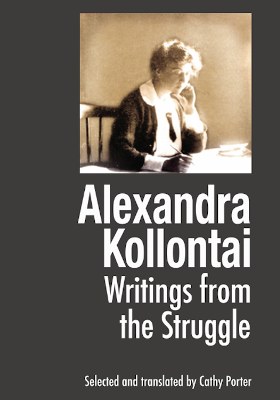
In those bleak years meetings were forbidden. But in Petrograd, at the Kalashaikovsky Exchange, those women workers who belonged to the Party organized a public forum on “The Woman Question.” Entrance was five kopecks. This was an illegal meeting but the hall was absolutely packed. Members of the Party spoke. But this animated “closed” meeting had hardly finished when the police, alarmed at such proceedings, intervened and arrested many of the speakers.
It was of great significance for the workers of the world that the women of Russia, who lived under Tsarist repression, should join in and somehow manage to acknowledge with actions International Women’s Day. This was a welcome sign that Russia was waking up and the Tsarist prisons and gallows were powerless to kill the workers’ spirit of struggle and protest.
In 1914, “Women Workers Day” in Russia was better organized. Both the workers’ newspapers concerned themselves with the celebration. Our comrades put a lot of effort into the preparation of “Women Workers Day.” Because of police intervention, they didn’t manage to organize a demonstration. Those involved in the planning of “Women Workers Day” found themselves in the Tsarist prisons, and many were later sent to the cold north. For the slogan “for the working women’s vote” had naturally become in Russia an open call for the overthrow of Tsarist autocracy.
Women Workers Day During the Imperialist War
The first world war broke out. The working class in every country was covered with the blood of war.6 In 1915 and 1916 “Working Women’s Day” abroad was a feeble affair – left wing socialist women who shared the views of the Russian Bolshevik Party tried to turn March 8th into a demonstration of working women against the war. But those socialist party traitors in Germany and other countries would not allow the socialist women to organize gatherings; and the socialist women were refused passports to go to neutral countries where the working women wanted to hold International meetings and show that in spite of the desire of the bourgeoisie, the spirit of International solidarity lived on.
In 1915, it was only in Norway that they managed to organize an international demonstration on Women’s Day; representatives from Russia and neutral countries attended. There could be no thought of organizing a Women’s Day in Russia, for here the power of Tsarism and the military machine was unbridled.
Then came the great, great year of 1917. Hunger, cold and trials of war broke the patience of the women workers and the peasant women of Russia. In 1917, on the 8th of March (23rd of February), on Working Women’s Day, they came out boldly in the streets of Petrograd. The women – some were workers, some were wives of soldiers – demanded “Bread for our children” and “The return of our husbands from the trenches.” At this decisive time the protests of the working women posed such a threat that even the Tsarist security forces did not dare take the usual measures against the rebels but looked on in confusion at the stormy sea of the people’s anger.
The 1917 Working Women’s Day has become memorable in history. On this day the Russian women raised the torch of proletarian revolution and set the world on fire. The February revolution marks its beginning from this day.
Our Call To Battle
“Working Women’s Day” was first organized ten years ago in the campaign for the political equality of women and the struggle for socialism. This aim has been achieved by the working class women in Russia. In the soviet republic the working women and peasants don’t need to fight for the franchise and for civil rights. They have already won these rights. The Russian workers and the peasant women are equal citizens – in their hands is a powerful weapon to make the struggle for a better life easier – the right to vote, to take part in the Soviets and in all collective organizations.7
But rights alone are not enough. We have to learn to make use of them. The right to vote is a weapon which we have to learn to master for our own benefit, and for the good of the workers’ republic. In the two years of Soviet Power, life itself has not been absolutely changed. We are only in the process of struggling for communism and we are surrounded by the world we have inherited from the dark and repressive past. The shackles of the family, of housework, of prostitution still weigh heavily on the working woman. Working women and peasant women can only rid themselves of this situation and achieve equality in life itself, and not just in law, if they put all their energies into making Russia a truly communist society.
And to quicken this coming, we have first to put right Russia’s shattered economy. We must consider the solving of our two most immediate tasks – the creation of a well organized and politically conscious labour force and the re-establishment of transport. If our army of labour works well we shall soon have steam engines once more; the railways will begin to function. This means that the working men and women will get the bread and firewood they desperately need.
Getting transport back to normal will speed up the victory of communism. And with the victory of communism will come the complete and fundamental equality of women. This is why the message of “Working Women’s Day” must this year be: “Working women, peasant women, mothers, wives and sisters, all efforts to helping the workers and comrades in overcoming the chaos of the railways and re-establishing transport. Everyone in the struggle for bread and firewood and raw materials.”
Last year the slogan of the Day of Women Workers was: “All to the victory of the Red Front.”8 Now we call working women to rally their strength on a new bloodless front – the labour front! The Red Army defeated the external enemy because it was organized, disciplined and ready for self sacrifice. With organization, hard work, self-discipline and self sacrifice, the workers’ republic will overcome the internal foe – the dislocation (of) transport and the economy, hunger, cold and disease. “Everyone to the victory on the bloodless labour front! Everyone to this victory!”
The New Tasks of Working Women’s Day
The October revolution gave women equality with men as far as civil rights are concerned. The women of the Russian proletariat, who were not so long ago the most unfortunate and oppressed, are now in the Soviet Republic able to show with pride to comrades in other countries the path to political equality through the establishment of the dictatorship of the proletariat and soviet power.
The situation is very different in the capitalist countries where women are still overworked and underprivileged. In these countries the voice of the working woman is weak and lifeless. It is true that in various countries – in Norway, Australia, Finland and in some of the States of North America – women had won civil rights even before the war.9
In Germany, after the Kaiser had been thrown out and a bourgeois republic established, headed by the “compromisers,”10 thirty-six women entered parliament – but not a single communist!
In 1919, in England, a woman was for the first time elected a Member of Parliament. But who was she? A ‘lady’. That means a landowner, an aristocrat.11
In France, too, the question has been coming up lately of extending the franchise to women.
But what use are these rights to working women in the framework of bourgeois parliaments? While the power is in the hands of the capitalists and property owners, no political rights will save the working woman from the traditional position of slavery in the home and society. The French bourgeoisie are ready to throw another sop to the working class, in the face of growing Bolshevik ideas amongst the proletariat: they are prepared to give women the vote.12
Mr. Bourgeois, Sir – It Is Too Late!
After the experience of the Russian October revolution, it is clear to every working woman in France, in England and in other countries that only the dictatorship of the working class, only the power of the soviets can guarantee complete and absolute equality, the ultimate victory of communism will tear down the century-old chains of repression and lack of rights. If the task of “International Working Women’s Day” was earlier in the face of the supremacy of the bourgeois parliaments to fight for the right of women to vote, the working class now has a new task: to organize working women around the fighting slogans of the Third International. Instead of taking part in the working of the bourgeois parliament, listen to the call from Russia:
“Working women of all countries! Organize a united proletarian front in the struggle against those who are plundering the world! Down with the parliamentarism of the bourgeoisie! We welcome soviet power! Away with inequalities suffer by the working men and women! We will fight with the workers for the triumph of world communism!”
This call was first heard amidst the trials of a new order, in the battles of civil war it will be heard by and it will strike a chord in the hearts of working women of other countries. The working woman will listen and believe this call to be right. Until recently they thought that if they managed to send a few representatives to parliament their lives would be easier and the oppression of capitalism more bearable. Now they know otherwise.
Only the overthrow of capitalism and the establishment of soviet power will save them from the world of suffering, humiliations and inequality that makes the life of the working woman in the capitalist countries so hard. The “Working Woman’s Day” turns from a day of struggle for the franchise into an international day of struggle for the full and absolute liberation of women, which means a struggle for the victory of the soviets and for communism!
Down with the world of Property and the Power of Capital!
Away with Inequality, Lack of Rights and the Oppression of Women
– The Legacy of the Bourgeois World!
Forward To the International Unity of Working Women and Male
Workers in the Struggle for the Dictatorship of the Proletariat
–The Proletariat of Both Sexes! •
Endnotes
- Tsarist Russia still used the old Julian calendar of the Middle Ages, which was 13 days behind the Gregorian calendar used in most of the rest of the world. Thus March 8 was “February 23” in the old calendar. This is why the revolution of March 1917 is called “the February revolution” and that of November 1917 “the October revolution.”
- Clara Zetkin was a leader of the German socialist movement and the main leader of the international working women’s movement. Kollontai was a delegate to the international conference representing the St. Petersburg textile workers.
- This is not accurate. The vast majority of unskilled workers in England, France and Germany could not vote. A smaller percentage of working class men in the United States could not vote – in particular immigrant men. In the South of the US black men were often prevented from voting. The middle class suffrage movements in all the European countries did not fight to give votes to either working class women or men.
- At its 1903 Congress, the Russian Social Democratic Labour Party divided into two wings, the Bolsheviks (which means “majority” in Russian) and the Mensheviks (which means “minority”). In the period between 1903 and 1912 (when the division became permanent) the two wings worked together, unified for a while, split again. Many socialists, including entire local organizations, worked with both wings or tried to stay neutral in the disputes. Kollontai, an active socialist and fighter for women’s rights since 1899, was at first independent of the factions, then became a Menshevik for several years. She joined the Bolsheviks in 1915 and became the only woman member of their central committee. She also served as Commissar of Welfare of the Soviet Republic and head of the Women’s Section of the Bolshevik Party.
- August Bebel (1840-1913) was a leader of the German Social-Democratic Party. He was a well-known supporter of the women’s movement and author of a classic book on Marxism and women, Die Frauenfrage translated into English as Woman Under Socialism, which has been translated into many languages.
- When war broke out in 1914, there was a massive split in the international socialist movement. The majority of the Social Democrats in Germany, Austria, France and England supported the war. Other socialists, such Kollontai, Lenin, the Bolshevik Party and Trotsky in Russia, Clara Zetkin and Rosa Luxemburg in Germany and Eugene Debs in the United States, to name some of the leaders, denounced the pro-war socialists for being traitors to the working class and to the fight for a workers’ revolution.
- The word “soviet” means “council.” Soviets, or workers’ councils, are democratic bodies in which delegates are elected in factory and neighborhood meetings and are controlled by their sister and brother workers. The representatives of the soviets must report back to their constituency and are subject to immediate recall.
- After the working class seizure of power in October/November 1917, the Russian workers’ state was faced with two major problems. One was an invasion by thirteen countries, including the United States; the second was resistance by the pro-monarchist and pro-capitalist elements in Russia. Primarily under the direction of Leon Trotsky, the soviets created a workers and peasants army, the Red Army, which defeated the forces of counterrevolution.
- Women had won the right to vote in several of the United States prior to World War I. A federal amendment guaranteeing all women over 21 the right to vote was passed on August 26, 1920. It was not until the 1960s that the last legal barriers to working class people voting in the United States were abolished.
- The “compromisers” Kollontai is referring to are the Social Democratic leaders who formed a new capitalist government in Germany after the fall of the Kaiser in 1918. They actively supported counterrevolution after coming to office.
- While the aristocratic Lady Astor was indeed the first woman to serve in the British parliament, the first woman elected to parliament was the Irish revolutionary Constance Markievicz. Together with other members of the Sinn Fein party, she refused to take her seat in the imperial parliament.
- French women did not finally get the vote until after World War II.



